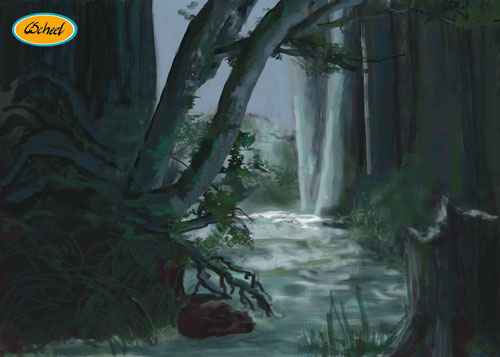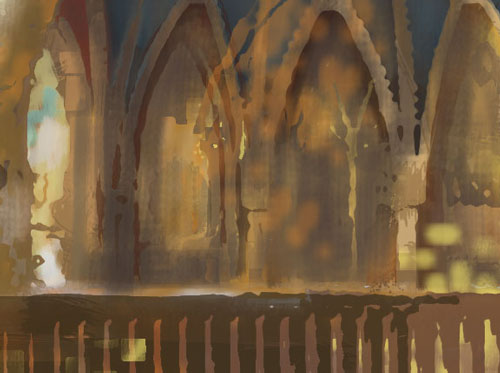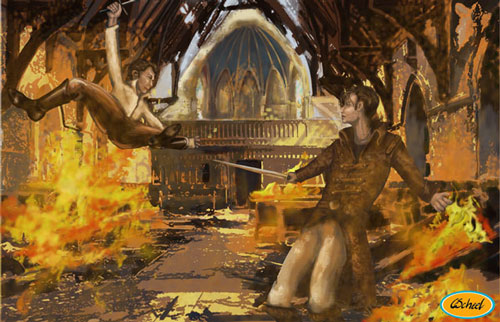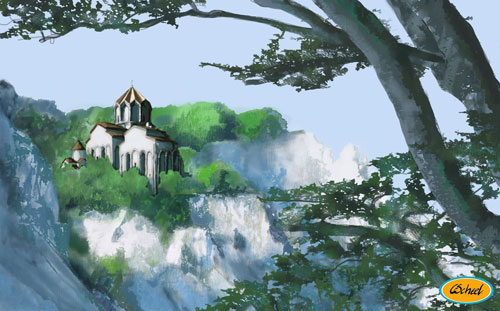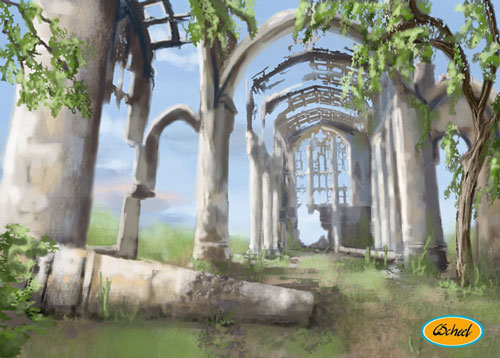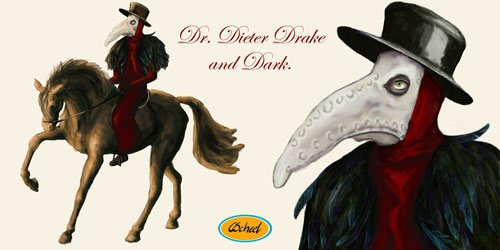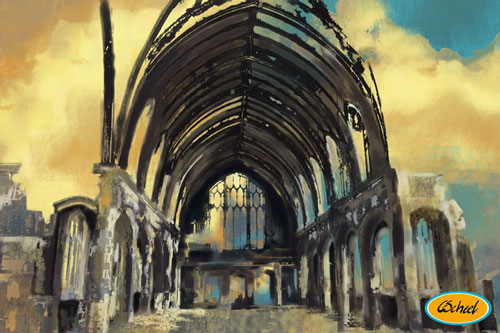Fields of the black death.
- introduction to a game design.
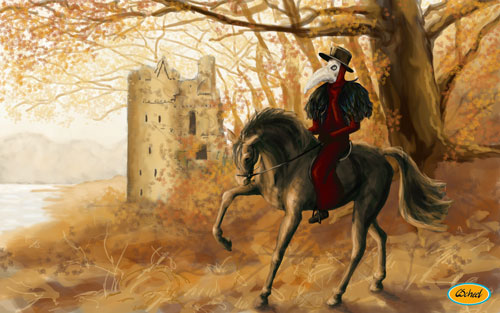
Image description: When the plague doctor comes to visit.
The digital concept art is from 2015 and produced with the use of brushes in Photoshop.
The horse man is a dr. Dieter Drake, arriving on his impressive stallion Dark.
The image is done in the golden colors of autumn.
General concept and ideas :
This project began as a concept art project, with the sense of a game design. During the process the game design has emerged.
The overall game design have three focus topics:
Epidemic
Fear
Theory of mind or mentalization (Do not worry, there will be an explanation)
History:
I have chosen to create a game design that do not aim at being historic correct, but contains elements from the history, These elements will be used dramatically.
I have chosen to distance the project from history and only use the fundamental idea or the core of the concepts, because I think that it makes it relevant for our current situation, than a discussion of whether or not the details are correct.
There are elements picked directly from history, twisted a bit and then placed in the game design, because they are interesting in themselves and gives variation over the theme, perhaps more out of range from what I could have imagined from scratch.
The plague arrived, possible on a ship via the silk road to Messina and spread to among other places Venice. Back then it was believed that the a specific group of people was the cause of the plague, believe me the history on its own is interesting, even in a perspective of today.
Epidemics;
The intension with the project is to show some of the interesting essence of the history, such as the plague and the spreading of the plague, the understanding of the disease and the combat f the epidemic as a general representation of epidemics and their consequences. This includes the reactions and the decisions that followed.
I have found the plague interesting because it was profound for the west, it turns the world upside down during the centuries it rampaged, socially, politically and because it challenged so many areas of living it also functioned at a catalyst for development in sciences and understanding.
The peasants could make demands because of the shortage of labor as a consequence of the high death rates, as well as the people that dies because they was blamed for the causing the plague.
The peasants could make demands because of the shortage of labor as a consequence of the high death rates, as well as the people that dies because they was blamed for the causing the plague.
Infectious diseases and epidemics also rampage today. one of the big one that have cause the largest changes have, as I sees it, is AIDS, but also a number of influenza and other infectious diseases. ADIS does not plays the same role as it did some years ago, the virus have largely been contained and the treatments have been improved, but even today people fear both AIDS and HIV, and a part of those fears are based on myths.
I do not think that one should believe everything that can be viewed on the medias, even though this claimed to be a scientific program, any way they6 claimed to have found a change in dna, widely spread in Europe , due to the survivors of the plague, this change made them less exposed to get infected by HIV and AIDS.
The majority that have survived the plague had this cellular change and passed it on the next generations, and traces of this can still be found today.
Epidemic have often be used in games or films that takes place sometime in the future, I have chosen to go in the opposite direction, because history can show us something about our reactions and consequences that actually have taken place, even if it is my interpretation of history, besides it is not as scary as an uncertain future. The historic perspective also gives me an opportunity to play with elements that almost are based on historical fact, or something like that.

Image description: the bird mask.
A digital work of concept art from 2015.
The images portrays a man dressed in a bird mask, the mask was believed to protect against the plague, therefore it was worn by the doctors whom was fighting the plague. I have partly chosen the mask for its effective visual expression.
Mortality, a race against time and fear:
In one of my prior game designs called "Once I was a Knight" one of the points was that the population could become extinct and take the player along with it in the fall, as an outer consequence.
This could also be the case here, but where it before was an ethical dilemma as a part of the user interface, the consequence of the choices here are not as clear in terms of right and wrong.
The central dilemma here is a bit more complex and makes the difference between saving a single individual against the majority, as well as convey and convince others, that might not see the world the same way as you, and do it in such a way that they will attempt your ideas. There are more parameters involved and therefore more thing that can potentially go wrong.
The mortality during the plague was not 100%, but more or less 50%, which means that a lot of the people that got infected did not die from the plague, but survived the infection.
Some people was killed because they was suspected of contaminating the water, this would be the Jews, this adds to the total mortality numbers, even though they did not do anything like that.
I have chosen not to take in the prosecution of the Jews, but the use representatives for people of a different believe system than the Catholic, not that I have anything particularly against the Catholics, it is thread of history that I have chosen to follow in order to give an idea of the view of the world at that time.
The outsiders are, here, the infidels and the witches.
The one message:
I have not created this to advocate for or against a certain believes system, on the contrary, my only message in this could be seen as this; to let doubt have a reasonable place, in other words, to point out that history shows us, that even when we have been absolutely sure of something, we have been wrong before.
A race against time:
Infectious diseases and epidemics spread not only over distances but also in time, the longer the time, the more people risk getting infected, and the higher the risk of people dying.
Ergo the game have a build in race against time: More people gets infected, more people dies, more people gets accused as infidels and witches and killed.
The less people that survives, the lesser the victory for the player, if the players character survives.
Fact check;
It is possible that it would be a good idea to put out a number of historic correct and controlled material, then what is a part of the game design, so the players can check the fact or if they become interested in the historic material.
It is also possible that it the game design could be closer to history than what is present, but the experience, I think should take priority.
. I do not wish for specific historic details to take priority over this or for it to get in the way of a better game experience, nor should it become a big research load at this time in the process, since the three focus principals, as mentioned in the beginning, should be at the center of the design.
This may of course be founded in my own culture, history or educational background, but a fact check or a link to rich historic material would be good.
Which bring me to the last challenge in the game design, to see-through and navigate in a world unlike the one that you are used to, and that sees the world differently from you, the player.
Today, the majority of the world agrees that a solution to a disease can be some kind of medication, but the medication that we have today did not exists in the middle-ages.
There are however still diseases for which we do not have effective medication.
Today we also know, that an effective way to contain a bacteria that causes diseases like the plague can be contained by quarantine.
The player might have a pretty good idea of how to approach a problem like this, but the world that it takes place in does not, so how to handle that? How to convince the other participants in the fight against plague?
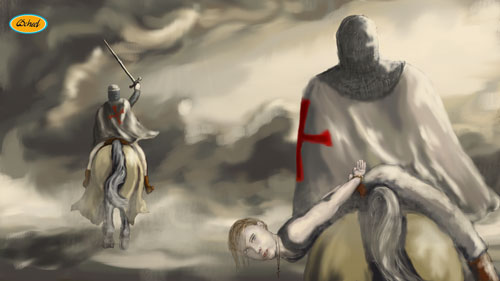
Image description: On the back of a horse.
Digital concept art from 2015. The image portrays a man being transported on the back of a horse, without knowing where he is going.
He has been captured by knights. The knights are dressed in none original and made up suits or clothes, that has no references to any particular group of knights.
The image is created in Photoshop using brushes.
Mentalization or Theory of mind, and strategy;
As a core element in this game design, apart from the dramatic consequences, is an attempt to make the previous times world image and idea some alive, partly by letting the player meet and the culture and believes, expressed by figures in the game design, but also by concrete dramatic elements in the game design.
The play will however often have the advantage of knowing what it may take to overcome plague, and therefore have one advantage to get tuned into the solutions and connections, but the missing experience with the world or world of idea´s may be a challenge.
The player may cause resistance and become the hunted object or become blocked by others, even though the player may know that they are right, that their solutions will solve the problem, and even if their intensions are good, they may run into trouble.
The challenge therefore becomes to read and navigate in a different world, even though it may not be completely right and try to come up with a compromise that will work, in order to win the game.
The player then have to navigate in a way that take the believes of the surroundings into consideration, while trying to solve the challenges.
Theory of mind or mentalization is the ability to generate an idea or theory about the other characters perspective, and in the game then try to guess a possible path forward.
The player may have to adjust this theory along the way or come up with several of these for the different characters.
This may sound complicated but maybe an example will help.
Example ;
One of the tests of mentalization or theory of mind, is about visualizing how the other person sees the world and what they know, here to imagine where the other person would look for an item.
. Let's pretend we are watching a movie together, the hero hide a treasure on an island.
She digs a shallow grave beneath a palm tree.
The crook comes by, finds the treasure and hide it in a cave, while our heroine is fishing. the heroine comes back to look for the treasure.
Where do you think that she will look for the treasure?
Now it is not going to be that simple, so the player will instead have to guess a reaction from the surrounding, from another time, that had other believes and ideas about the world.
This understanding of others are the foundation for social interaction and empathy
You win the game by making sure that as many as possible survives, including the player.
It is a single player game, because it is important that the player can to some degree see the coherence between their own choices and the consequences in the surroundings, multiple players would disrupt and disturb this process, and make it less transparent for the player.
I have chosen to let the game design and the storyline be the overall guidelines, therefore specific game genres are secondary, are submissive to how they function in the context, before anything else.
Power, hierarchy, research and interpretation.
Strictly speaking this is not intended as a historical correct project for reasons such as artistic dramatic freedom, and a priority of the central part, the theory of the mind concept, but the following is a kind of interpretation of my research that intends to operate as a framework and inspiration.
The plague was at its worst in a short period from 1346 1353 so that it is approximately the period I have chosen to focus on.
It is the end of the Middle Ages and at the same time the beginning of the Renaissance.
In the renaissance you start to se a separation of church and state where this was not previously separated.
One of the Italian kings is century previously been so humiliated that he had to fall on his knees for the Pope, although in the following period it has improved, but the king has lost power and so has the nobility.
The Roman Empire has in a period been in power, but after a period where there has been disputes about who should be the next emperor, is the realm gone in decay and has shrunk.
A second major power factor, the Roman Catholic Church, wobble because there are three different who claim to be true Pope.
The Kingdom of France will have one pope, Rome a second, Pisa a third and the Roman Empire cant decide.
The southern part of Italy, the Kingdom of Naples, are in favor of the same line of Popes as France, the so-called Avignon line, while the northern part of Italy are in favor of the line from Rome.
There are a number of attempts to solve this problem, some of which makes the problem worse.
After the standards of the time, people were divided into three;
• those who are fighting, the nobility
• Those who are praying, the clergy
• and those who work, therefore peasants.
Peasants are working for and used by both of the other two groups.
There were also lawless parts of the nobility at the time and general lawless.
In general were the only ones there were allowed to fight, the nobility and otherwise there was among the peasants a kind of an eye for an eye and a tooth for a tooth mentality, which neither the church or the king thought was in order. In their minds, only the nobility were allowed to fight and they all consider themselves to have broad powers. They presses and exploit the population.
Slowly there is cities or groupings with the intention to protect citizens by forming communities. The cities of promise to defend each other. The citizens themselves conspire.
In the north of Italy developed cities to City-states, while cities or groupings was rarer in southern Italy.
Within these cities it is difficult for the king and the church to maintain their power but they try, why riots was quite widespread.
The aristocratic feudal society, with retention peasants, or copyholders, will be slowly replaced by taxes and an economic value based approach.
The concept of property begins to replace past understanding of land ownership. The ones who owned the land were in power in the various territories as that of the nobility, went in heritage.
There is no real legal practice, but courts availed themselves of traditional practices and rules.
Especially in the northern and central parts of Italy of old Roman controlled cities survives, although it is mostly on a sleep, as administrative centers for a diocese or as the local representative of a remote empirical power.
Some towns are founded on long-haul trade, or you did woolly wipes, which was very widespread.
Market towns could be the basis for a city or municipality of appearance, or it could be fortified areas belonging to a Count, Bishop or a territorial abbot.
Other towns were founded around a market or other local trade sites.
There were collected or charged funds among the city's citizens in order to be able to build walls around the towns. The walls to protect citizens against attacks and vengeance from outside.
Citizens are opposed arbitrary taxation and will even regulate their internal affairs, instead of succumb to the harassment from the king, Bishop, abbot or the counts, which viewed the citizen as the non-noble social outsiders. Citizens struggled to keep such as a market which could otherwise run the risk of being sold at a high price or given away by the king or the emperor.
Citizens were ruthlessly harassed, extorted and subjected to oppression.
The citizens gets, nevertheless more power, since so many people die as a result of the plague and therefore become a shortage of labor.
The former clear social boundaries come under pressure.
At a time, there is not enough men for the armies, so they take mercenaries into armies, also from other parts of the world. Armies is something the King, the Emperor or a higher member of the nobility have or have at their disposal.
A count or a duke often spearheaded their own armies, and could make it available to the church or the king. In the south of Italy, which at this time is the kingdom of Naples, local armies are therefore not made available for the Roman emperor. The king is the ruler and is not subject to the Roman Empire, in the same degree as previously.
Nobility could be knights who either chose to follow a kind of knight moral code, i.e. fight for the common good, for justice and have respect for women, or they could be lawless and just do as it suited them, which in general meant that they were looted and stole.
It was usually nobility or the royals whom was clergy, or as held the powerful positions. Peasants had no opportunity to improve their social status.
There is no prisons, but you can be held captive, which is not seen as a punishment, it is just to await the punishment. It is mostly in the cellars under castles or public buildings etc.
There are generally few types of punishment;
• The death penalty, usually means to be burned on the stake or the likewise.
• Flogging
There are different forms of torture, in the game described as interrogations, one of them is the wheel, where he will be bound to a wheel and beaten with a club.
To be flooded is another form of questioning or torture: most commonly used in connection with the witch hunt, means to tie the hands and feet together, after which they are thrown in water and see whether they go to the bottom. If they float, they will be considered witches and will be burned at the stake, if they go to the bottom they are innocent. This is mostly women.
Punishment is not decided by the people or by a social function, but by the kings men, nobility or the clergies, based on religion and tradition.
There was after all probability not witches in reality, but faith in the witches was strong and it was the fear of them also.
If you were appointed as witch, you would then be socially outcast, mostly because of something they had nothing to do with and no influence upon. It was often forced upon older women, or wise wives, but it could also be forced upon young women.
A currency in the Middle Ages, which was produced in Florence was the florin. Since the game takes place at the end of something reminiscent of the Silk Road by something similar to Messina and quarantine station has its origin in the south of Italy, so I have chosen the currency to be florin.
The stages.
The prerequisites for the stages is that there are clear separations between each of the stages, i.e. either a sign or change in the scenarios, available cities etc., unless one would like want a more complicated but elegant solution, where the overlaps are more smoothly.
The players infections numbers decreases with time, approximately 2 points per 10 second and influenced by the player's actions in the game.
For all other characters the infections number for 50% of the characters drops over time with -2 points per 10 seconds, while the infections number for the other 50% of the characters increases over time with 2 points per 10 seconds in the game.
The player clicks on a character to indicate that she/he will speak or interact with the other character, which is a risk of infection. This applies even if the player want to fight them or if they owe the player a favor.
The first stage of the game:
The infection rate in the first stage of the game is between 0-40, the chance that a character is infected is 1/4.
By contacting a character the contamination being transferred is 50% of a random contamination between 0-40, if the character is infected at contact.
If there have been built a quarantine station in the city, then the chance that a character is infected to drops1/6, of the characters outside the quarantine station.
In a quarantine station is 80% of the characters in quarantine infected.
On this stage of the game, players are treated like a peasant or citizen. This means that the clergy or the nobles can be dismissive or rude. Unless they owes the player a favor, see description under charcter types below.
The second stage of the game:
The infection rate of the second stage of the game is between 0-60, the chance that a character is infected is 1/3.
By contacting a character 50% of a random contamination between 0-60 is transferred, if the character is infected by contact.
If there is built a quarantine station in the city the chance of a character being infected drops to 1/5, for characters outside the quarantine station.
In a quarantine station the chance of a character being infected is 80% of those in quarantine.
At this stage of the game there can be an active persecution of Jews.
If there is a persecution of Jews, then there is a risk of one fifth of the population will be killed as a result of the persecution.
The second stage of the game and up:
Citizens are treated better, but favors can still be helpful.
Third stage of the game:
The infection rate in the third stage of the game is between 0-80, the chance that a character is infected are ½.
By contacting a character 50% of a random contamination between 0-80 is transferred if the character is infected at contact.
If there is built a quarantine station then the chance that a character is infected drops to ¼, for character whom is outside the quarantine station.
In a quarantine station is 80% of the characters in quarantine are infected.
If there is an active Jew persecution at this stage in the game, then there is a risk to ¼ of the population will be killed as a result of the persecution.
Maps in "Fields of the Black Death"
From the GUI the player can click the earth or map symbol in the upper right corner.
Maps then comes in two types; local relevant to the players position, and global, the overview.
Here are some suggestions:
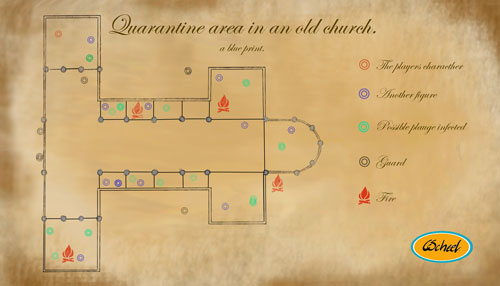
This is a local map, for a scene were the player are in quarantine in a old church.
This gives on overview of the scene, antagonists, challenges and a possible escape route.
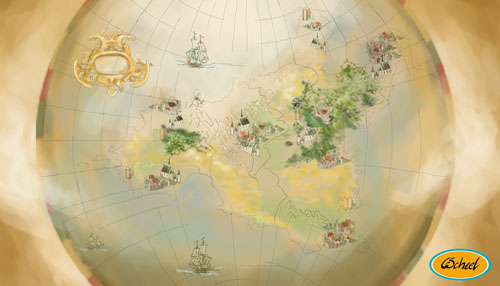
This is an example of a global map, or an overview of the available game world.
There should be an indication of the position of the player, later on.
The map itself may change along the way.

This is also a global map, but here there are indications of where the plague have infected the majority of the population. This is the gray areas.
The idea is that the player should be able to follow the overall progression of the infection or the epidemic , in order to estimate time issues.
The fields are also gray, because when people dies, then no one takes care of land and then the crops dies, a limited amount of food resources is the result.
Plenty of this to steal though, but not much to buy, in other words inflation.
Visual isometric prototype of the environment and impact of the stages.
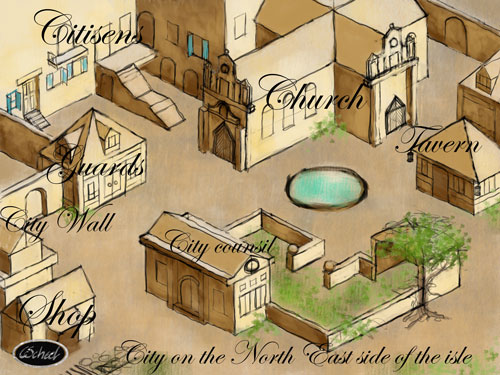
Here is a range of prototypes of the north-western part of the north-east city.
What is tested is the light and the isometric view of the city.
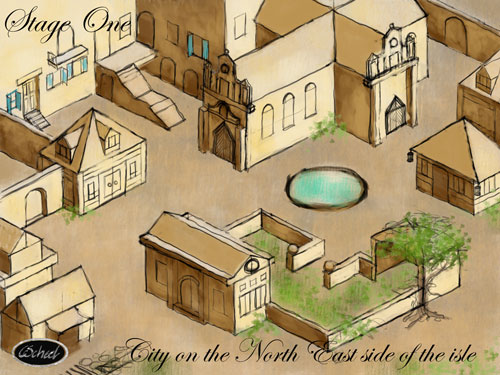
This is not final versions, but tests or sketches. This visual prototype only work with light, none of the elements in this test have color of their own. The color of the bricks, gravel or wood is therefore not represented, but only the light inclination and its tone at the elements.
The view is isometric, i.e. there is no genuine perspective, but an artificial version of a perspective with no disappearances points. The isometric view is selected, since only a small part of the image will be seen, at any time, in the game. The viewing angle, therefore must be able to move around without distorting the perspective. Therefore isometric perspective, which are not affected by the viewpoint, have been selected.
Isometric perspective is often used in games.
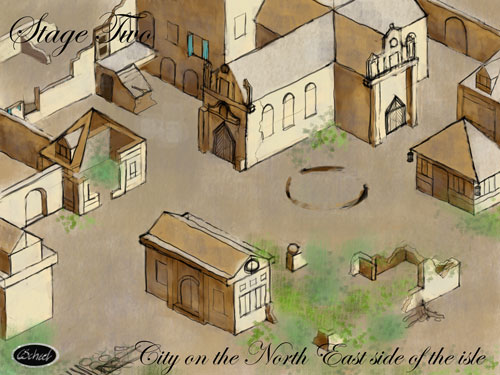
The stages as described above, affects the environment, here the city.
In the first stage is all positive and that is why the light warm and saturated, while the light in the later stages is faded and colder, while the city decays.

Test of isometric perspective, depth and colors.

The house is the guards, here colored in natural colors, a combination of light and the objects own color.
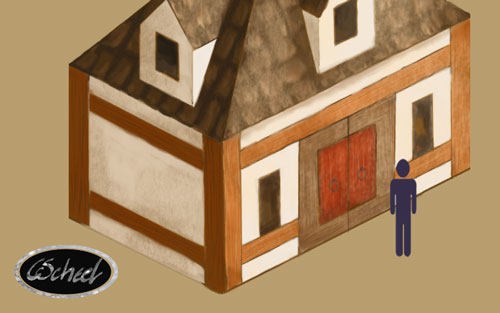
In the image above shows a screenshot of a small test made in unity webplayer.
Controls are A S D W or the arrow keys.
The trick here is to get the player to move in front of or behind an object,
here the guards house.
Isometric depth test.
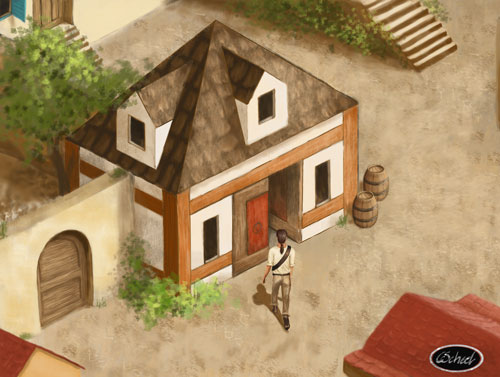
The image above is an illustration of how it could look in game.
The point system in general, version 1:
You can buy from the sellers all over town, you can steal all over town and you can do none of the above. If you do none of the above, you are most likely to die from hunger, infection or in battle.
Death on this level and until the end game, means that you end up in limbo, looses all your possessions for a while.
Death by natural causes;
parameters are called, death till healthy
and give between 0-100 points
You can get infected during contact with people, small rodents, death or alive. Infections wears off in time, rest or food, so it is possible to regain health, if you are not exposed again.
You can die from plague, be wounded in battle or by other accidents, ( Since they once believed that the world was flat, I am considering an option to be able to sail over the edge, but it is historical incorrect, since they did know that the earth was round at the time, but it could be fun. This should earn you a trip to limbo)
You can come back from limbo, but at some point you are going further than that, and the figure dies, unable to come back, at least in the end game.
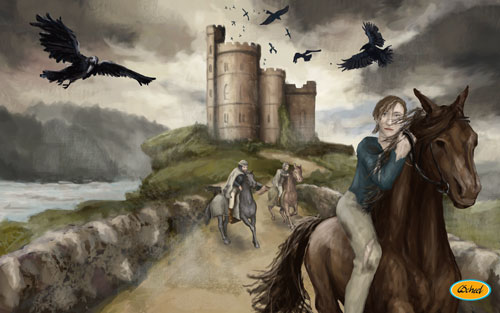
Images description: Enemies on your train or run, baby run..
A digital piece of concept art from 2015, done in Photoshop, with the use of brushes.
It is about escaping captivity and running from the knights.
A parameter called infidelity,
what we today labels crime often goes against the ten commandments it also goes against the religion, the points range from 0-100. Points large enough, means that if captured, and in prison, you are most likely to be hanged and ending up in limbo. From limbo you might be able to return, at least until the end game
Punishment for crimes: I f you steal, but are undetected, nothing will happen. If you are detected, you will build a reputation as a thief, infidel. There are eyes where you least expect it, cats, children, birds gossip of your presents. They are however not particular effective, but they are there, especially if you are up till something. The worse your reputation as an infidel or a witch, the easier they will detect you.
If you insists or advocate a point of view that is not a part of the religious belief, you then risk getting points as infidel, this includes point of views that today are considered science or truth. There is a difference as to how these points of views are perceived, pending on their nature.
If you get in a combat with a privileged citizen, guards or knights then your reputation as an infidel will have increased(criminals or murderer), if you hit beggars, infidels(criminals or none believers) prostitutes or even kill them, it counts for less, but it will add to your reputation as an infidel, because it goes against the 10 commandments.
The next parameter is called witchcraft
and runs from 0-100 points.
Penalty for witchcraft: I you kill infidels or witches you will build a reputation as a beliver, even if you later on might need their help, or information. Information to move on in the game. If your points for witchcraft are larger than a certain number, you will be hunted for it, if you get caught you will end in prison.
If you insists or advocate a point of view that is not a part of the religious belief, you then risk getting points as a witch, this includes point of views that today are considered science or truth. There is a difference as to how these points of views are perceived, pending on their nature.
If you are perceived as a witch, you will be hunted and if you do not escape captivity, you risk getting the death penalty for witchcraft, if you witchcraft scores are too high.(It could be possible to talk your way out of it or pass their test) where you end up after death, depends on the state of the game and the total score of the player.
The parameter faith
ranges from 0 - 100 points.
If you are a true believer, then the infidels and the witches will have trouble come to you, and that might affect your chances of solving the quest. Points for fait can eliminates some of the consequences for some of the other points
Point system, in details:
For more details, please use this link.
The points system version 3
points system here has four main parameters;
•Hunting status
•Penalty
•Orthodoxi.
•Health.
Hunting status is about the extent to which the game's character is sought.
Penalty is about the level of penalties to waiting.
Orthodoxy is about the faith of players characters actions in the game and is calculated from two other parameters, namely faith and infidelity.
If the character has too many infidelity points in relation to the number of faith points, a penalty is waiting and the character can be hunted because of his misdeeds.
Health is about the characters health and is based on two other parameters, namely wounds and infection. Infection with the plague has an impact on whether you will be hunted and if there will be a penalty in the form of quarantine, provided this is invented and the player is reached to stage 2 in the game.
I have made a small test of the points system that is based on random variables within each area.
Unlike in the game itself, this is no time parameter, i.e. to wounds and infection numbers do not decline over time, which I intend to do in the game, but here they simply be replaced by a new calculation.
I have divided the parameters so that they are dependent on each other in a hierarchy, i.e. ;
The character is in live but not completely recovered
after which level of infection is taken into account
then for orthodoxy.
The character is in live and completely healthy
after which level of orthodoxy is taken into account .
The character is not in live,
after which level of orthodoxy is taken into account .

Gui version 1.
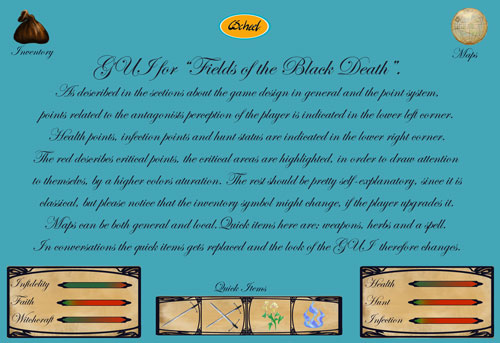
As described in the sections about the game design in general and the point system, points related to the antagonists perception of the player is indicated in the lower left corner.
Health points, infection points and hunt status are indicated in the lower right corner.
The red describes critical points, the critical areas are highlighted, in order to draw attention to themselves, by a higher color saturation.
The rest should be pretty self-explanatory, since it is classical, but please notice that the inventory symbol might change, if the player upgrades it.
Inventory in here is the little purse in the upper right corner.
Maps can be both general and local, the symbol in the top right corner.
Quick items here are; weapons, herbs and a sort of spell, in the center bottom of the GUI.
In conversations the quick items gets replaced and the look of the GUI therefore changes.
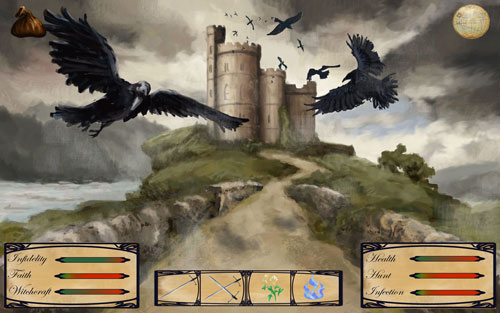
In game the GUI looks like this.
The GUI version 2.
The points system is primarily adjusted to be more logical, but also to create a clearer and more user-friendly GUI.
The player does not need to be able to see all the details in the status at all times in the game, but need to know the most fundamental.
There is however a journal the player can check in order to see the details along the way and it is these details which can be seen in the small test program of the points system, above.
I have chosen that the player should be able to form a company and there is, therefore created a space for this in the GUI, but theses windows should not be there if the player does not have any company.
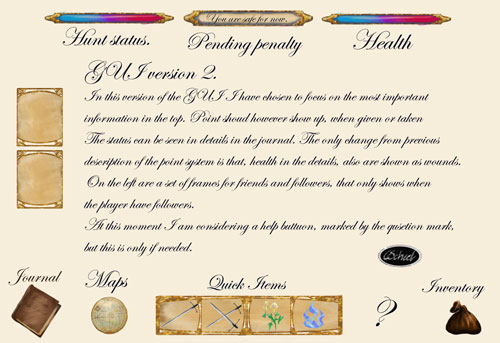
Here you can see an example of how the GUI a would look like in the game.
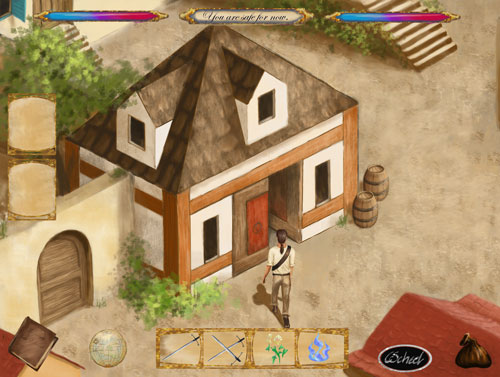
The Theory of mind or Mentalization in a game design.
In the following I have transposed the theory of mind so that it is cooperating with the game design in the selected context and the development of the general story. This is based on some research, interpretations and modifications of what I have found useful in the game. It can therefore not be regarded as a historic correct but an interpretation of the circumstances and version of possible scenarios.
First reviewed a simplified version of the different character types possible reaction and idea of the world, then it translates to a range of options in dialogs and action.
Then there is a review of the consequences for the player and the possible score.
It is important to understand that although consequences and pre-understanding are described here, they are not visible for the player, the player will have to imagine what the impact of any action will be, by using theory of the mind, in contrast to what the reader of this description need to do. The reader may instead , please use empathy and theory of mind to imagine how the experience of the player may be.
What is schematically described here is not the final dialogs, but those parts of the dialogs there must be present in order to support the game play.
There is nothing to prevent that a character can be totally different and fall completely outside the dialogs described here.
It is therefore possible to have a character whom is very dismissive and almost just grunts to speech, from whom the player has to find a way to get the character to give out information or some sort of thing.
Characters can have variations of the elements in the dialog with or without extra additions, i.e. that there are differences in which things on the list of things to prevent the plague and therefore differences in question made during absolution, or there may be differences in the treatments provided.
The expressions and the use of language may be different, i.e. the one can be very friendly and courteous, while another is strict and reserved, or a cheerful drunkard.
This part of the process is important to make the characters come live and the dynamic of the dialogs, as most possible.
The potential for developing and color characters are numerous, although there are fundamental parts that must be present in order to get a level to work in relation to the overall history and context.
The point about the doubt, expressed by the difference between what the most know limited the plague, namely quarantine, and this universes faith in various strange treatments, cures and precautions.
Since we cannot know what humanity will discover in the future, our understanding and performances may appear in the same way as the medieval methods and understanding, seems to us.
Sketches of a character design - Jake Edwards..
Previous I have circled around a design of the main character in the game, here I have focused in on a specific design.
Previous I have also reflected a possible change of the game concept from the original 3D concept into an isometric 2D concept, therefore is the character here isometric.
I have chosen to work with the portrait first, here in a perspective angle first, and there after in the isometric angles.

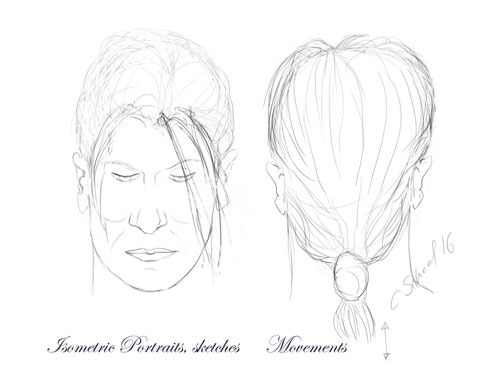
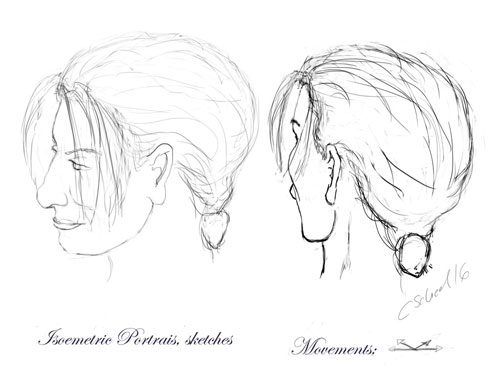

Fields of the black death.
- Concept art.
